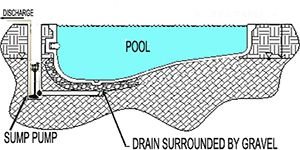What Is A Pool Sump Pit?

An inground pool sump pit, commonly referred to as a dewatering system or dry pit, may not be something you are familiar with. A dewatering system is an underground area that measures the ground’s water table level.
As excess groundwater builds up in the pit, you can remove the water using a sump pump. This setup ensures the longevity and efficiency of the equipment while reducing potential hazards associated with water exposure. You have probably seen a dewatering system around an inground pool without realizing it.
Royal Pools G2 Landscaping has installed inground pools in Northwest Indiana for over 25 years. We know just how vital sump pits are to the longevity and durability of your swimming pool. If you’re unfamiliar with these systems and want to know more, you’re in the right place. What is a pool sump pit? Let’s get into it!
Purpose of an Inground Pool Sump Pit
The primary function of a sump pit is to remove groundwater from around the pool. A buildup of groundwater around the pool causes hydrostatic pressure to push against the pool walls. This could cause a fiberglass pool to pop out of the ground. With a sump pit, you can drop a sump pump down into the pit and remove the water that has accumulated.
How an Inground Pool Sump Pit Works
An inground pool dry pit is constructed as a waterproof underground chamber near the pool equipment area. Typically, pool builders will dig a hole (8″ – 10″ in diameter) near the deep end that will serve as the pit housing.
The dewatering system is strategically placed to allow groundwater to flow toward it below the pool base. This draws water away from the pool, building up water in the pit. As water builds up in the pit, remove it using a sump pump.
Benefits of Using a Sump Pit
- Enhanced Equipment Protection – Keeps pumps, filters, and electrical components dry, reducing wear and tear.
- Improved Safety – Minimizes the risk of electrical hazards in a wet environment.
- Better Aesthetics – Conceals bulky pool equipment, keeping the pool area visually appealing.
- Space Optimization – Frees up space around the pool deck by moving equipment below ground.
- Lower Maintenance Costs – Reduces damage from moisture exposure, prolonging the lifespan of pool systems.
Considerations for Installing a Sump Pit

Pool owners must consider factors before installing a dewatering system, including:
- Soil conditions
- Water table levels
- Accessible for maintenance
Proper construction with high-quality materials and expert waterproofing is essential to ensure long-term durability and effectiveness. This separates the good contractors from the poor contractors.
Conclusion
An inground pool sump pit is a practical investment for pool owners looking to protect their equipment and improve safety. By keeping the ground around the pool dry, a sump pit enhances the efficiency and lifespan of the equipment while maintaining the aesthetic appeal of the pool.
Proper planning and installation maximizes these benefits, making pool maintenance easier and more cost-effective in the long run. When researching pool builders, be sure the companies you’re looking into offer dewatering systems built into their pool packages.
If you want to keep learning about all things inground pools, check out these articles below. For more educational pool and landscaping content, check out our learning hub.
Top 3 Most Popular Thursday Pools Fiberglass Designs of 2025
Which Type of Inground Swimming Pool Leaks the Most?
Vinyl Liner Pool Rundown: Pros, Cons, And Manufacturing Process
Written By Logan Edgemon
